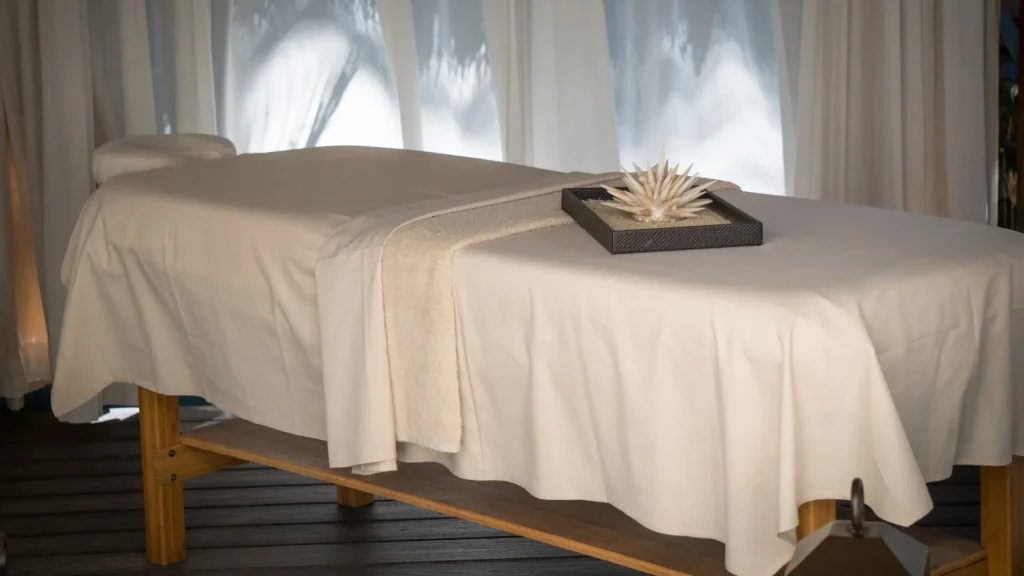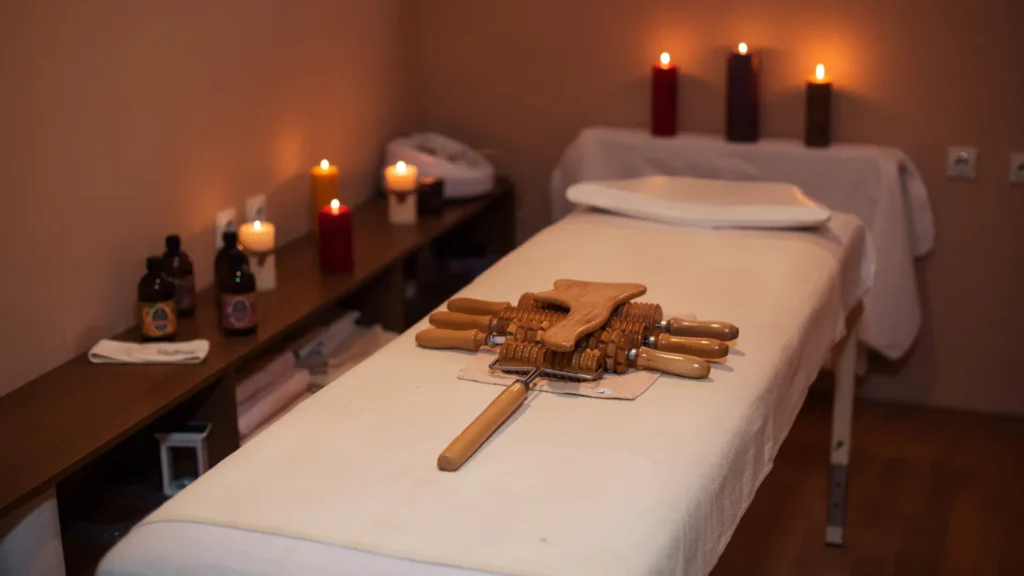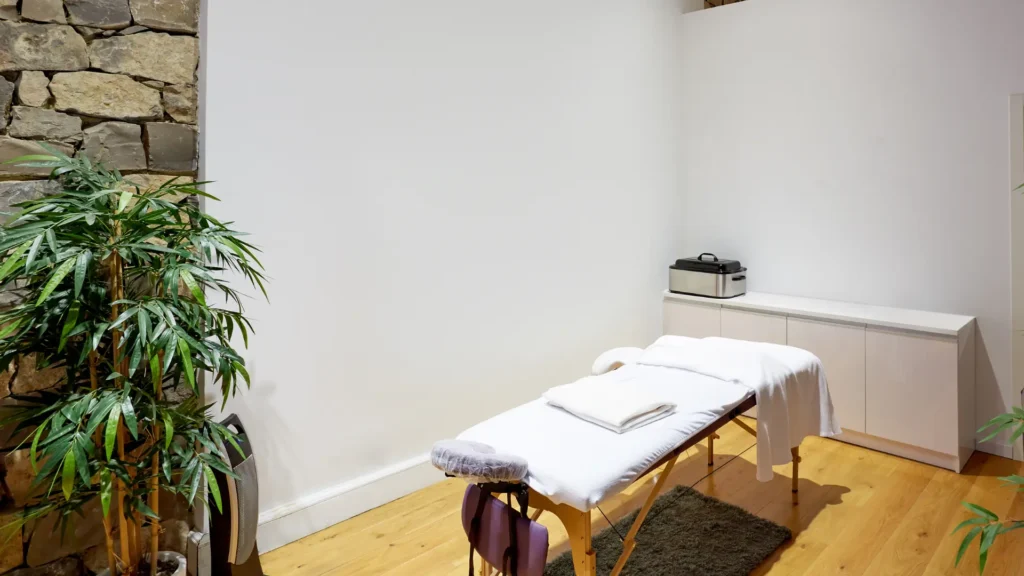In this blog post on “What Size Massage Table is Best?”, you’ll discover:
- The importance of choosing the right table size for both clients and therapists.
- Key factors to consider when picking a table size.
- Expert advice and frequently asked questions to help guide your decision.
Ready to crack the code on the perfect massage table size? Stick around, because I’m about to make this complex choice a whole lot easier for you!
Quick Answer To Perfect Massage Table Sizes:
The ideal massage table size depends on various factors. Consider client diversity, therapist ergonomics, the type of massage you offer, and your room’s dimensions. While standard sizes exist, customization and adjustability can be valuable options. Take your time to choose wisely; it’s an investment in your practice’s success and your clients’ satisfaction.

Jump To:
Importance of Table Size in Massage Therapy
Let’s get down to business! Size does matter, and we’re not just talking about pizzas and TVs. When it comes to massage therapy, picking the right table size is crucial for two big reasons:
- Client Comfort: Imagine lying on a table that’s too small. You’d feel like a giant in a dollhouse, right? A table that’s too large isn’t any better; you might feel lost. In short, the right table size helps your clients feel safe, snug, and ready for some serious relaxation.
- Therapist Ease: Now, let’s flip the coin. If you’re the one giving the massages, the table size can make your job easier or, well, a total nightmare. A too-small table means you’re stretching and reaching like a gymnast, and that’s no good for your posture. A too-big table? You could end up walking laps just to get from head to toe!
Bottom line: the table size matters for both the client’s comfort and the therapist’s ease of work. And you thought this was going to be simple, didn’t you?

Factors to Consider When Choosing a Massage Table Size
Okay, now that we’ve established why size is a big deal, let’s talk about how to choose the right one.
Buckle up, because we’re diving into some must-know factors:
- Client Size: You’ll meet clients of all shapes and sizes. Picking a table that’s adaptable is key. The goal is a Goldilocks situation—just right for everyone!
- Therapist’s Height and Reach: If you’re shorter, a narrow table will let you reach your client without a struggle. If you’re taller, a wider table won’t leave you hunching over like the Hunchback of Notre Dame. Ergonomics, anyone?
- Type of Massage Therapy: Not all massages are created equal. Deep-tissue or sports massages might need more space for movement, while something like reflexology can manage with less. Know your craft!
- Room Size: Last but not least, where are you setting up shop? A table that’s perfect in every way but doesn’t fit in your room is, well, not so perfect. Measure your space, and then measure it again. Trust us on this one!
By now, you should have a clearer picture of what to look for. Don’t rush the process; take your time and consider these factors carefully. Your clients (and your own well-being) will benefit from your thoughtfulness!
NOTE: If you’re looking for the perfect massage Tables, I’ve already prepared a List for you. Check it Here: Top Massage therapy tables to choose from: A Must Have List
Standard Massage Tables Sizes
So, you’ve got your tape measure in one hand and this blog in the other. What’s next? Well, it’s time to talk numbers!
Here are some commonly used dimensions for massage tables:
- Width: Usually between 28 and 32 inches. Wider might be better for bigger clients, but remember, you’ve got to reach across it!
- Length: Typically around 73 inches. Some tables come with extra head and foot rests, though, so keep that in mind.
- Height: Most tables have adjustable heights, often ranging from 24 to 34 inches. This is your friend, especially if multiple therapists will be using the table.
Feel like you’re in a math class yet? Don’t worry; it’ll all add up when you see the smiles on your clients’ faces—and when you’re not rubbing your sore back at the end of the day!
Table for Standard Massage Table Sizes
| Feature | Small Table | Medium Table | Large Table | Notes |
|---|---|---|---|---|
| Width | 25-27 inches | 28-30 inches | 31-33 inches | Wider tables offer more client comfort but can be harder for therapists to work around. |
| Length | 70-72 inches | 73-75 inches | 76-78 inches | Longer tables can accommodate taller clients but check room size. |
| Height | 24-26 inches | 27-30 inches | 31-34 inches | Most tables are adjustable. Consider the height of the therapist using it. |
By knowing these standard dimensions, you’ll be one step closer to picking the perfect table. But remember, ‘standard’ doesn’t mean ‘one size fits all’. Your unique needs may require some tweaking, and that’s totally okay!

Pros and Cons of Different Table Sizes
Alright, guys, it’s decision time! You know the factors to consider and the standard sizes. But wait, what are the pros and cons of each size category?
Let’s break it down:
- Small Tables
- Advantages: Easier to move around, great for tight spaces, and perfect for therapists with a shorter reach.
- Disadvantages: Might be uncomfortable for larger clients, and could limit the types of massages you can offer.
- Medium Tables
- Advantages: The middle ground is often the sweet spot. It’s versatile enough for various clients and massage types.
- Disadvantages: It may still be a bit tight for larger clients or those therapies requiring more space.
- Large Tables
- Advantages: Spacious and comfortable for the client. Ideal for deep-tissue and other expansive techniques.
- Disadvantages: Heavy and hard to move. Also, it can be a stretch—literally—for shorter therapists.
There you have it—the good, the bad, and the cozy! When choosing a table size, weigh these pros and cons carefully. Every massage therapy setup has its unique needs, so take your time to figure out yours.
Note: If you’re interested in more tips on selecting the best massage table size, you can also refer to our comprehensive guide on Tips to choose a massage table. It provides valuable insights and recommendations to help you make an informed decision.
Expert Recommendations on What Size Massage Table is Best
We’ve chewed over the basics and crunched the numbers, but why not sprinkle in some wisdom from the pros? After chatting with industry veterans and seasoned massage therapists,
here’s what they had to say:
- Go for Adjustable: Many experts suggest an adjustable height table. It’s like the Swiss Army knife of massage tables—super versatile!
- Think Long-Term: A table is an investment. Go for quality over bargain deals, and you won’t have to replace it anytime soon.
- Test Drive: Just like you wouldn’t buy a car without driving it, don’t purchase a table without trying it first. Some shops even let you rent before you buy.
- Personal Touch: Customization is key. Think about add-ons like armrests, headrests, or even heated pads. Your clients will love the extra thought you put into their comfort.
So there you have it, expert advice to guide your journey to the perfect massage table. It’s like having a panel of wise mentors, minus the long beards and mysterious proverbs!
Note: If you’re interested in exploring the best brands for massage tables as well, you can find detailed information in our guide on choosing the best brand for a massage table. It offers insights into reputable brands to consider for your massage therapy needs.
What is the Difference Between Static and Dynamic Weight on a Massage Table?
- Static Weight: This is the maximum amount of weight a table can hold when it is at rest, without undergoing any added pressure from movement. This weight capacity is usually much higher, sometimes even up to 2,000 to 3,000 pounds.
- Dynamic Weight: This refers to the amount of weight a table can handle during an actual massage, where there might be shifting, turning, or pressure applied. Dynamic weight capacity is generally lower than static weight and often ranges between 400 to 650 pounds.
It’s crucial to consider both static and dynamic weight when choosing a table, especially based on the types of treatments you’ll offer and the sizes of your clients.

FAQs Section
Do Massage Tables Sit Up?
Yes, many modern massage tables have a backrest feature that allows them to sit up, making them adjustable for different types of treatments. These are especially useful for treatments like reflexology, acupuncture, or certain types of head and facial massages. This feature provides both the client and therapist with more options for positioning and comfort.
How Much Room is Needed Around a Massage Table?
A general rule of thumb is to have at least 3 to 5 feet of free space around each side of the table. This ensures that the therapist has ample room to move around freely while performing the massage. Also, this space allows for other equipment, like massage oil stands or towel warmers, to be easily accessible. Always consider the total space, not just for the table but also for all the additional items you’ll need.
How Long Should a Massage Table Last?
The lifespan of a massage table can vary depending on the quality of its construction and how frequently it’s used. However, a well-built table made from quality materials should generally last between 5 to 10 years. It’s essential to regularly check for signs of wear and tear like weakening supports or fraying upholstery, to ensure it remains safe to use.
What is the Most Commonly Used Massage Table Width?
The most commonly used massage table width tends to fall between 28 and 32 inches. This range accommodates a wide variety of client sizes while still allowing the therapist to easily reach across the table. Therapists often choose a width based on their height and reach, as well as the specific types of treatments they offer.
Can a table be too big or too small?
Absolutely, yes. A table that’s too big can make it hard for the therapist to work effectively. Too small, and the client might feel cramped or uncomfortable.
How do I measure a massage table?
Grab a tape measure and note down the length, width, and height. If the table has additional extensions like head or foot rests, include those in your measurements.
What if I need a table for multiple types of massages?
In this case, a medium-sized adjustable table is your best bet. It offers the flexibility to accommodate different massage styles and client sizes.
Final Thoughts On What Size Massage Table is Best
We’ve gone the extra mile in this comprehensive guide on “What Size Massage Table is Best?” From the why’s to the how’s, and even some pro tips, we’ve covered it all.
Picking the right table size is more than a mere shopping decision; it’s an investment in your business and the well-being of your clients. Take your time, weigh the pros and cons, and remember—you’ve got this guide to refer back to whenever you’re in doubt.
Ready to make your final choice? Go ahead, and may your massage table be the canvas for countless moments of relaxation and healing!






